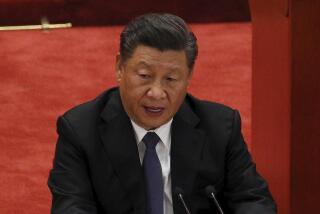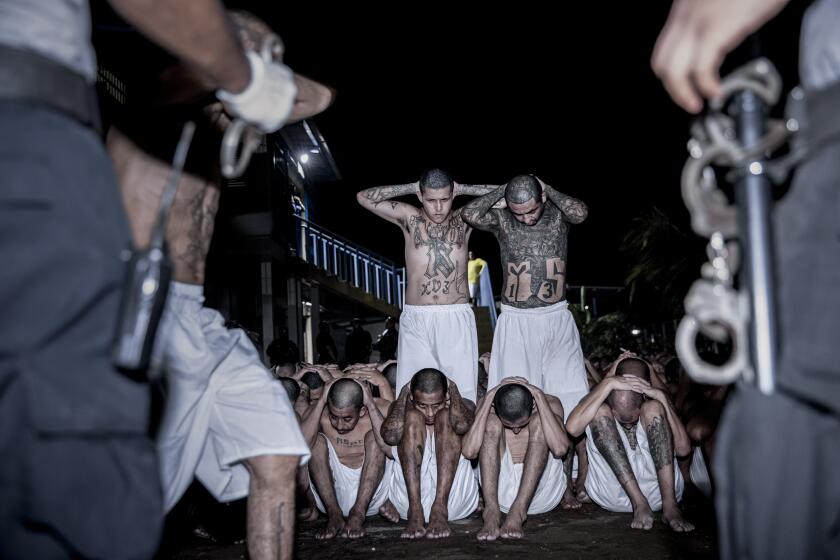Putting Vietnam Syndrome to Rest
“The Vietnam syndrome is over!” So proclaimed President Bush on Friday. He didn’t need to tell Iraqi dictator Saddam Hussein, who had tried to fight that war all over again.
And in a strange way, the Gulf War ended almost exactly as the Vietnam War did, just as Hussein claimed it would. But to his surprise, instead of playing the role of North Vietnam’s Ho Chi Minh, as he intended, he found himself playing the role of South Vietnam’s Nguyen Van Thieu.
In October, 1972, U.S. National Security Adviser Henry A. Kissinger met with Thieu to present the U.S. proposals to end the Vietnam War. As the Baltimore Sun’s Arnold Isaacs reported, Thieu commented bitterly that to the United States, South Vietnam was no more than a dot on the map. Its loss would mean little to the United States, which had its own strategies to pursue with Moscow and Beijing. “The bargain that had been struck,” Isaacs wrote, “was tantamount to surrender. . . . As he spoke, Thieu frequently wept.”
When Hussein got the word from his foreign minister, Tarik Aziz, about the meetings in Moscow last week, he might well have wept, too, for the Soviet bargain for Iraqi withdrawal from Kuwait again was “tantamount to surrender.”
The reason was the same--great power interests took priority, and Moscow had its own strategies to pursue with Washington. The flurry of meetings with Soviet President Mikhail S. Gorbachev were no more serious than Kissinger’s meetings with President Thieu almost two decades earlier. Both were designed to sell out an ally.
And at the operational and tactical level, the Vietnam syndrome led Hussein astray once more. Generals are often accused of trying to fight the last war over again, and that’s just what Hussein tried to do. Using the defensive tactics he had developed against the Iranians, he sought to draw America into another Vietnam War, defeating the United States not on the battlefield but on the home front by exhausting America’s patience and breaking its will through a bloody and drawn-out land campaign.
But the United States refused to play his game. For one thing, the “Vietnam syndrome” was largely confined to those who had never served there. As editor of Vietnam magazine for the past several years, I have noted that those who avoided the war, including many anti-war protesters, were much more guilt-ridden than those who had fought the war. The overwhelming majority of Vietnam veterans were proud of their service and had returned home and got on with their lives.
This was particularly true in the military. As I noted in my 1982 book, “On Strategy: A Critical Analysis of the Vietnam War,” most military officers blamed Gen. William C. Westmoreland for the loss of the war. That was grossly unfair to Westmoreland, but as a result, no “stab-in-the-back” syndrome ever developed in the American military.
Another reason no “Vietnam syndrome” developed in the military was that as it withdrew from Vietnam during the period 1969-1973 (two years before Saigon fell to the North Vietnamese), then-Army Chief of Staff Gen. Creighton Abrams and his successor, Gen. Fred Weyand, got the military’s mind off Vietnam by refocusing the Army’s attention on the North Atlantic Treaty Organization.
This refocus away from counterinsurgency and jungle warfare back toward conventional war on the plains of Europe led to a series of revisions of the Army’s how-to-fight manuals and ultimately to the development of air-land battle maneuver doctrine. Beginning in 1982, that doctrine was the basis for the Army’s organization for combat, for the way the Army was armed and equipped and for the way the Army trained for combat.
For almost 10 years, that doctrine was tested in field training within the Army and with joint Army-Air Force training exercises, especially at the National Training Center in the Mojave Desert and in joint NATO maneuvers in Europe.
The Marine Corps went through a similar metamorphosis in its post-Vietnam emphasis on maneuver warfare.
The payoff of all this training was Operation Desert Storm and the blitzkrieg that destroyed Hussein’s army. An old joke best explains Gen. H. Norman Schwarzkopf’s miraculous victory: “How do you get to Carnegie Hall?” asked the tourist. “Practice, man, practice,” was the reply.
The nine classic principles of war provide a framework for comparing the Vietnam and Persian Gulf wars. The first and perhaps the most important principle is that of the Objective. In Vietnam, 70% of the generals were uncertain of the goals of the war. That statistic might well have applied to the Iraqi army, but among coalition forces the objectives were clear.
The Offensive is the second principle--carry the war to the enemy and destroy his armed forces. The national policy of containment ruled out that principle in the Vietnam War. In the Gulf, the military’s hands were untied for the first time since World War II. It was a difference Hussein failed to anticipate.
Mass and Economy of Force are the next two interrelated principles. Mass dictates you put your main effort toward attainment of your main objectives, while secondary objectives are covered by an Economy of Force.
It was the Soviet Union that enabled the United States to mass its forces in the Gulf and leave an economy of force to guard Central Europe. In what Hussein must have seen as a terrible betrayal, his erstwhile Soviet ally gave tacit approval to removal of the U.S. VII Corps from Central Europe, where for decades it had guarded against a Soviet attack there.
It was that VII Corps, with its 1st and 3rd Armored divisions, its brigades from the 2nd Armored and 3rd Infantry divisions and its 2nd Armored Cavalry Regiment that provided the heavy punch for Gen. Schwarzkopf’s main attack. And getting them there involved yet another principle, that of Maneuver. Not only were forces moved from Europe, they were moved from the United States as well. The logistics task of transporting over half a million troops along with their arms, supplies and equipment was truly a Herculean effort.
Consider ammunition stocks alone. For planning purposes, the daily supply rate for an armored or mechanized division is 5,000 tons. Gen. Schwarzkopf said they had a 60-day supply on hand. That’s 300,000 tons. Then multiply that by all the U.S. and allied divisions in country and the figures are in the millions.
Security and Surprise are the next two reciprocal principles. In Vietnam, security was almost non-existent. But the coalition’s maneuver plans were kept secret to the very end, enabling the allied armies to achieve both operational and tactical surprise against the enemy forces. While there was some whining and sniveling about restrictions on press coverage, in the end the reasons for such restrictions were obvious.
The principle of Simplicity is a kind of litmus test for the other principles. The Vietnam War was one of the most complicated and convoluted wars ever waged, and the confusion demonstrated itself on the battlefield.
Desert Storm, by contrast, was the model of simplicity, especially in the lines of communication, command and control.
This was especially noteworthy, for, like Vietnam, politics made it impossible to achieve the principle of Unity of Command (that is, subordinating all forces to a single leader). But through cooperation among the allies, unity of purpose to a remarkable degree was achieved nonetheless in both the multination air campaign and the ground campaign that followed.
Operation Desert Storm was proof positive that the American military is not hobbled by a “Vietnam syndrome.” Perhaps now the politicians and the media can follow Bush’s advice and put that war behind them as well.
More to Read
Start your day right
Sign up for Essential California for news, features and recommendations from the L.A. Times and beyond in your inbox six days a week.
You may occasionally receive promotional content from the Los Angeles Times.






